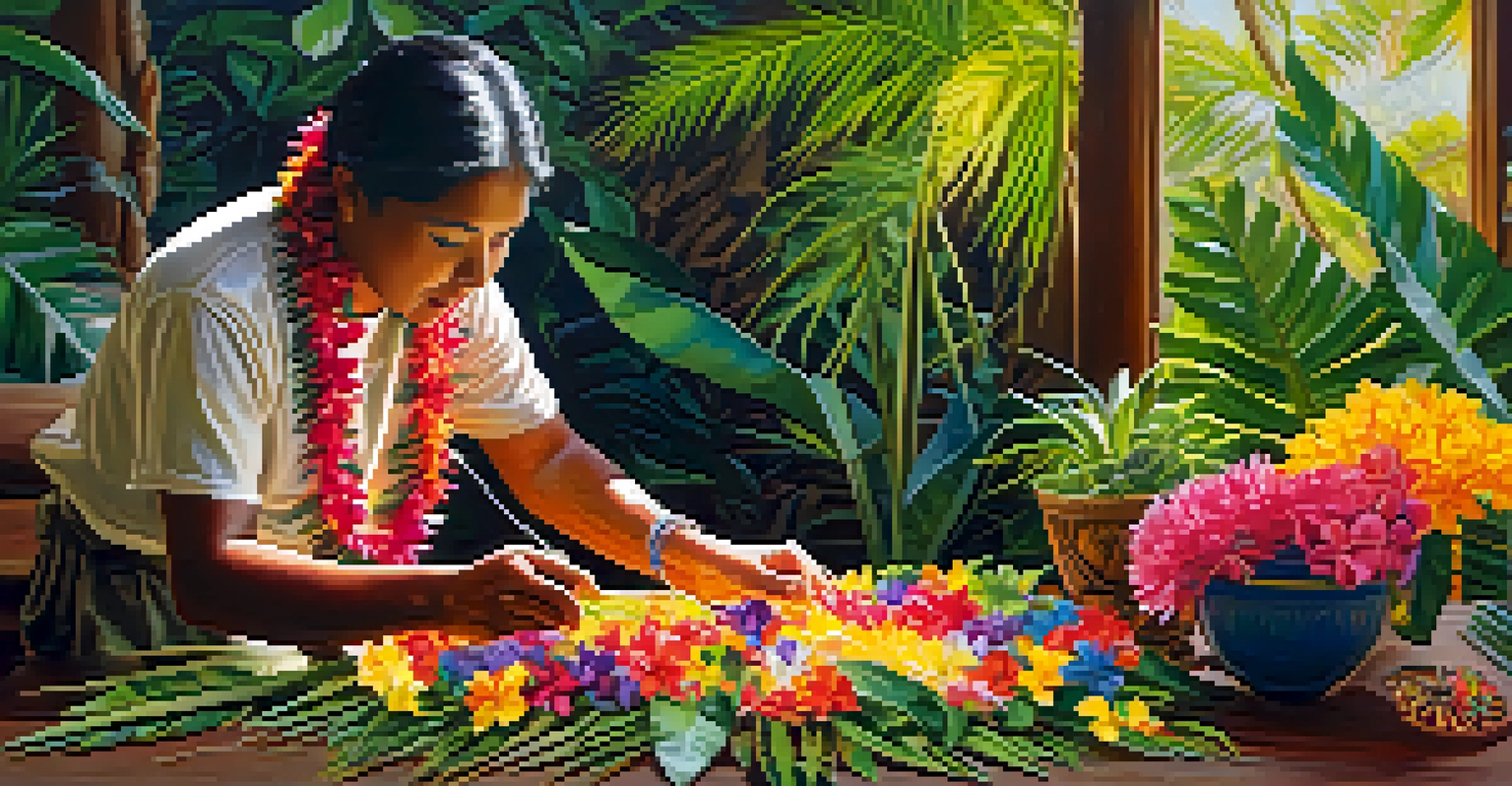Cultural Significance of Hawaiian Plants and Animals

The Role of Native Plants in Hawaiian Culture
Native plants hold a special place in Hawaiian culture, serving not just as resources but as symbols of identity. For instance, the 'ōhi'a lehua tree is often associated with the goddess Pele, representing love and passion. This connection showcases how flora is intertwined with mythology and everyday life, influencing everything from art to spirituality.
The things that we love tell us what we are.
Additionally, traditional practices like hula often incorporate native plants, using them in costumes and as offerings. The use of plants in hula not only highlights their beauty but also conveys stories and histories passed down through generations. This deep connection between plants and cultural expression reinforces the importance of preserving these species.
Moreover, the cultivation of native plants reflects a broader understanding of sustainability and respect for nature. Hawaiians have long practiced sustainable farming techniques, ensuring that the land remains fertile and vibrant for future generations. This commitment to ecological balance is a vital aspect of Hawaiian identity.
Animals as Cultural Symbols in Hawaii
In Hawaiian culture, animals are often viewed as spiritual guides and symbols of various traits. The Hawaiian monk seal, for example, is not only a unique marine mammal but also represents the importance of marine conservation efforts. Its presence reminds the community of the delicate balance between nature and humanity.

Similarly, the 'i'iwi bird, with its striking red feathers, is celebrated in stories and songs. Its vibrant color and melodic calls embody the beauty of the islands and serve as a reminder of the rich biodiversity found in Hawaii. The loss of such species would not only impact the ecosystem but also the cultural narratives that include them.
Cultural Significance of Native Plants
Native plants in Hawaii are deeply intertwined with cultural practices, mythology, and identity, highlighting the importance of preserving these species.
Furthermore, traditional practices such as fishing and hunting are deeply rooted in respect for animal life. These activities are often accompanied by rituals that honor the animals taken, reinforcing a sense of gratitude and responsibility towards nature. This cultural reverence for animals shapes how Hawaiians interact with their environment.
The Importance of Sustainability in Hawaiian Practices
Sustainability is not just a modern trend in Hawaii; it's a principle deeply embedded in traditional practices. Native Hawaiians have long utilized a system of sustainable agriculture known as 'aloha ʻāina,' which means love for the land. This philosophy emphasizes the interdependence of people and nature, guiding how resources are harvested and used.
In every walk with nature, one receives far more than he seeks.
For example, the cultivation of taro, a staple in Hawaiian diets, is steeped in cultural significance. It requires careful water management and is cultivated in lo'i (wetland fields) that reflect respect for water as a life source. This practice not only provides food but also fosters a strong community connection to the land.
By prioritizing sustainability, Hawaiians are also addressing contemporary environmental challenges. Efforts to restore native ecosystems and protect endangered species demonstrate a commitment to preserving cultural heritage for future generations. This holistic approach to resource management showcases the wisdom embedded in Hawaiian traditions.
Cultural Practices Involving Hawaiian Plants
Various cultural practices in Hawaii revolve around the use of native plants, showcasing their significance. For instance, lei-making is a cherished tradition where flowers, leaves, and even seeds are strung together to create beautiful garlands. These leis are often given during important events, symbolizing love, respect, and celebration.
Additionally, the use of plants in traditional medicine highlights their importance in healing practices. Many native plants are used for their medicinal properties, passed down through generations as natural remedies. This knowledge reflects a deep understanding of the plants' roles in health and wellness, emphasizing a holistic approach to care.
Animals as Spiritual Symbols
In Hawaiian culture, animals serve as spiritual guides and symbols, emphasizing the community's respect for nature and its biodiversity.
Moreover, Hawaiian cuisine often incorporates native plants, linking food to culture. Ingredients like taro and sweet potato are staples in local dishes, connecting people to their history and land. This culinary tradition not only nourishes the body but also reinforces the cultural identity of the Hawaiian people.
Hawaiian Mythology and Its Connection to Nature
Hawaiian mythology is rich with stories that intertwine the natural world with the spiritual realm. Many plants and animals are featured prominently in these tales, serving as symbols or characters that convey moral lessons. For example, the story of the demigod Māui showcases his adventures with various animals, highlighting their significance in the culture.
These myths often explain natural phenomena, linking the behavior of animals and growth of plants to the actions of gods and spirits. This connection fosters a sense of respect and reverence for nature, as it is seen as an extension of the divine. Understanding these stories allows individuals to appreciate the cultural significance of the environment.
Furthermore, these narratives are essential in teaching younger generations about the values and beliefs of Hawaiian culture. By sharing these stories, the community preserves its heritage and reinforces the importance of caring for the land and its inhabitants. Mythology thus serves as a bridge between the past and present, connecting people to their roots.
Conservation Efforts and Cultural Identity
Conservation efforts in Hawaii are not just about protecting the environment; they are also about preserving cultural identity. Many native species are endangered due to habitat loss and invasive species, prompting communities to take action. By engaging in conservation, Hawaiians are safeguarding their cultural heritage alongside the biodiversity of their islands.
Community-led initiatives often involve traditional ecological knowledge, emphasizing the importance of native plants and animals. These efforts are rooted in the belief that protecting the land is essential for maintaining cultural practices and community well-being. This dual focus strengthens both ecological and cultural resilience.
Sustainability in Hawaiian Practices
Traditional Hawaiian practices prioritize sustainability, reflecting a deep-rooted philosophy of caring for the land and ensuring ecological balance.
Moreover, educational programs aim to raise awareness about the cultural significance of Hawaiian flora and fauna. By engaging younger generations in conservation efforts, the hope is to instill a sense of responsibility and pride in their heritage. This connection between culture and conservation reinforces the idea that a healthy environment is integral to a vibrant cultural identity.
The Future of Hawaiian Flora and Fauna in Culture
As Hawaii faces environmental challenges, the future of its native plants and animals remains uncertain. However, the cultural significance of these species continues to inspire efforts towards preservation and education. By recognizing their role in cultural identity, communities are motivated to protect the natural treasures of their islands.
Innovative initiatives, such as community gardens and reforestation projects, are emerging to restore native ecosystems. These projects not only enhance biodiversity but also serve as living classrooms for cultural education. They offer opportunities for individuals to connect with their heritage while actively contributing to conservation.

Looking ahead, the challenge will be to balance modernization with the preservation of cultural practices. By fostering a deep appreciation for native plants and animals, the hope is to create a future where Hawaiian culture thrives alongside a healthy environment. This ongoing dialogue between culture and nature will be vital in shaping the identity of future generations.